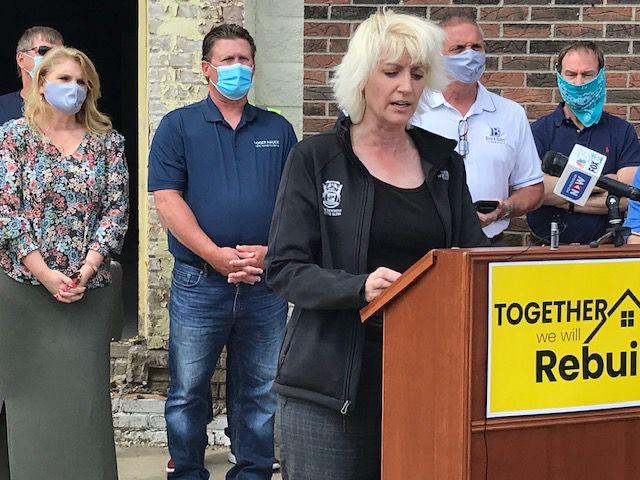Mackinac Center report surmises state agencies and Boyce at fault in Midland dam failures

Rep. Annette Glenn, R-Midland, announces a bill, which, if passed, will grant $6 million to assist Midland County and the City of Midland recover from massive flooding caused by the failure of two dams on the Tittabawasee River.
(The Center Square) – The Mackinac Center for Public Policy on Thursday morning released a report on the dam failures in Midland County this past May.
The report analyzes the events and actions prior to heavy rains causing the failure of the Edenville Dam and breaching of the Sanford Dam. The subsequent flooding wrought an estimated $200 million in property damage.
The report, titled “The Midland County Dam Failure,” was authored by Jason Hayes, MCPP environmental director, who concluded: “The growing weight of evidence appears to show that both the dams’ owner and the state agency charged with regulating the dam allowed for the conditions that enabled a historic flood to push the Edenville Dam to rupture.”
The report was released less than a week after the dam’s owner and operator, Boyce Hydro LLC, filed for protection in the U.S. Bankruptcy Court for the Eastern District of Michigan in Bay City.
The Edenville Dam was obliterated on May 19, after 4.7 inches of rain fell on Midland County the previous weekend while up to eight inches of rain fell immediately north in Gladwin County during the same time period.
“In any other year, the choices made by Boyce Hydro Power, the owner of the failed dams, and state regulators, working in the Department of Environment, Great Lakes, and Energy, might not have led to the failure of the Edenville and Sanford dams,” Hayes wrote. “But a major rainstorm compounded the regulatory and financial storms facing Boyce Hydro, and, together, these factors stressed the dams beyond their breaking point.”
According to Hayes, the Michigan Department of Environment, Great Lakes and Energy (EGLE) is claiming it noted safety concerns about the dam after it assumed jurisdiction from the Federal Energy Regulatory Commission pulled Boyce’s license to generate and sell hydroelectricity in October 2018.
However, Hayes also wrote: “Despite this claimed concern, it is important to note that EGLE’s initial inspection report did not recommend repairs or upgrades to the dam. Although the report did briefly note the revocation of the FERC license, it did not mention limited spillway capacity and did not recommend further inspections.”
He added EGLE had access to more than eight engineering reports published between 1973 and 2015 when they assumed regulatory authority over the Edenville Dam. EGLE was also aware of preliminary findings from a summer 2019 inspection of the dam conducted by The Spicer Group, a Saginaw-based engineering land surveying and architectural company, which indicated the dam did not meet state regulatory spillway requirements.
As well, Hayes’ reported Spicer was told by EGLE the company’s report raised “concerns related to classified information.” According to Hayes, Spicer’s compliance with EGLE’s concerns was “inaccurately characterized” by the State “as a ‘refusal’ by Spicer to reveal its findings.
Hayes’ report also concludes EGLE operatives misrepresented the state’s role in ordering the Boyce raise the water levels on the impoundments between the dams, which rendered the company incapable of conducting mandated spillway repairs.
“EGLE appeared to prioritize environmental concerns over spillway capacity,” Hayes wrote. “State regulators expressed concerns about the water levels in Wixom Lake and the potential impact drawing it down might have on the endangered snuffbox mussel (Epioblasma triquetra) and other freshwater mussel species.”
Hayes report adds that he received an email from Nick Assendelft in which the EGLE spokesperson claims the department did not require Boyce Hydro to alter water levels, and directed blame at the hydroelectric company.
“An EGLE document showing a chronology of events says the department issued a permit to raise lake levels after the request was made by Boyce. That permit approval was followed by a May 28, 2019, Midland Circuit Court ruling that also ordered Boyce Hydro to increase lake levels,” Hayes stated.
Boyce also argued the threat of a $300 million lawsuit from EGLE and the Michigan Department of Natural Resources for “alleged damages to freshwater mussels” this past April 2020 as well as continued pressure from residents on the dam impoundments prompted the company to raise water levels.
“On May 1, the Michigan attorney general, EGLE and MDNR responded by suing Boyce in the circuit court of Ingham County for ‘dramatically lower[ing] the level of Wixom Lake for an extended period in [December of ] both 2018 and 2019 … causing the death of thousands if not millions of freshwater mussels many of which are federally endangered,’” Hayes wrote.
Hayes’ report concludes the upcoming independent investigation of the dams’ failure “could show Boyce Hydro’s inability to maintain the dams was the cause, or a cause of the failure. It could also show that EGLE’s demand to raise the water from its December 2019 level to approved summer levels in the spring of 2020 played a role in the dam’s failure. It may also implicate aspects of FERC’s multiyear regulatory interactions with Boyce.”

